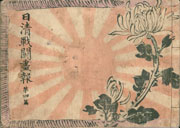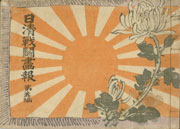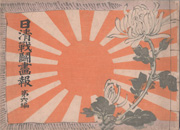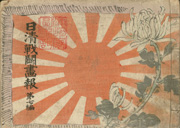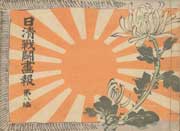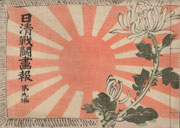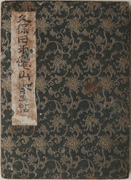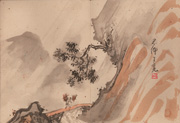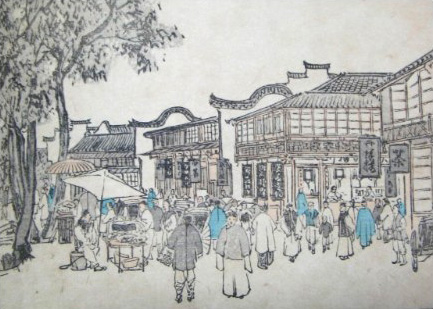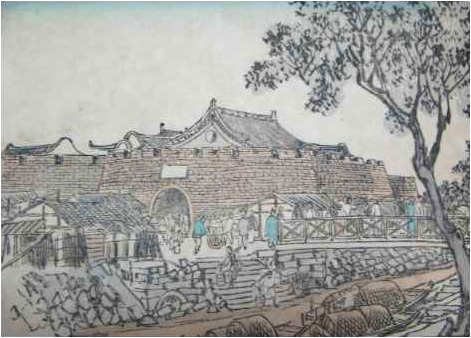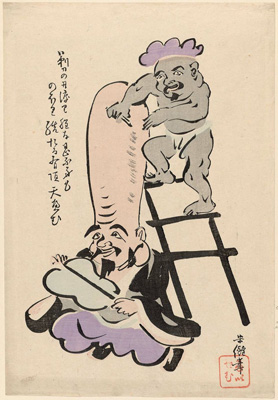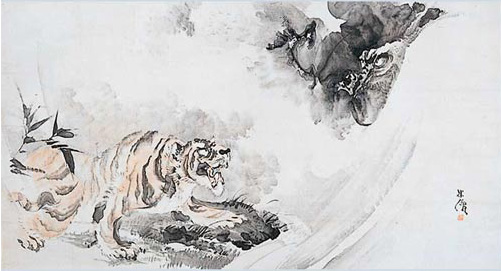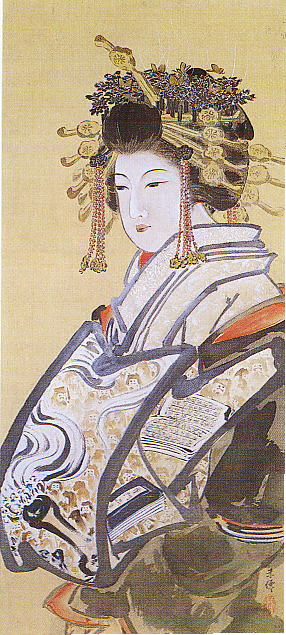Prints in Collection
Illustrated Account of the Sino-Japanese War, Volume 3, December 2, 1894
IHL Cat. #1627
| IHL Cat. #931 | Illustrated Account of the Sino-Japanese War, Volume 6, January 25, 1895 IHL Cat. #1609 |
Illustrated Account of the Sino-Japanese War, Volume 7, February 28, 1895 IHL Cat. #1012 | Illustrated Account of the Sino-Japanese War, Volume 8, March 25, 1895 IHL Cat. #549 | |
Biographical Data
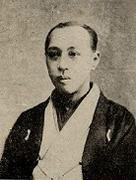 | ProfileKubota Beisen 久保田米僊 (1852*-1906) Kubota Beisen was a painter, famous enough to be asked to paint in Emperor Meiji’s presence, a journalist who accompanied the Japanese army in the field during the Sino-Japanese War (1894-1895) (and was himself pictured as such in several war triptych prints), an illustrator who created drawings for both Japanese and Western books, and a teacher of both Japanese and American artists. | 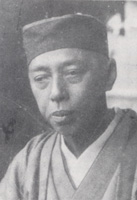 |
* Merritt in Woodblock Kuchi-e Prints: Reflections of Meiji Culture gives the artist's birth year at 1851.
Biography
Kubota Beisen 久保田米僊 (1852*-1906)Sources: A Dictionary of Japanese Artists: Painting, Sculpture, Ceramics, Prints, Lacquer, Laurance P. Roberts, Weatherhill, 1976, p.94; Woodblock Kuchi-e Prints: Reflections of Meiji Culture, Helen Merritt and Nanako Yamada, University of Hawaii Press, 2000, 205-206.
Family Name: Kubota Hiroshi 久保田寛 (but, Merritt gives the family and given name as Kubota Mitsuhirō, noting that in his youth he was called Beikichi.)
Azana: Kampaku 簡伯
Gō: Beisen 米僊 , Jinkaitōda (or Jinkai zuda) 塵芥 頭陀, Kinrinshi 錦 鱗 子, Kusanoya 草の屋 ,
Shirōken 紫 楼 軒 Gyoson kusa no ya 漁村 草 廼家, Shiōan 紫逢庵
Sources: The Sino-Japanese War, Nathan Chaikin, self-published, 1983, p. 33-34; Woodblock Kuchi-e Prints: Reflections of Meiji Culture, Helen Merritt and Nanako Yamada, University of Hawaii Press, 2000; and as footnoted.
Beisen was born in Kyoto in 1852 to Yamagiya Otoshichi, an inn-keeper.1 From an early age he displayed a love of drawing. Chaikin, cited above, tells us that the young artist painted graffiti on houses in his town including renditions of severed heads that he had seen displayed on the banks of the Kamogawa, which he was subsequently made to whitewash over. His father, expecting his son to follow him as an inn-keeper, did not encourage his artistic bent. However, at the age of 16 he was allowed to study with the Kyoto painter Suzuki Hyakunen (1825-1891) in the evenings. An 1898 letter from the journalist and editor Fukai Eigo, written to Arthur Diósy, founder of the Japan Society, discusses Beisen’s early struggle to pursue his passion.
| His father, once discovering the secret pursuits of the future artist, went so far as to throw his brushes, and other materials for drawing, into a river near by. The career of one of the masters of pictoral (sic) art in Japan was begun under these unfavourable circumstances, and it was only after his parents perceived the failing health of their son that Kubota Beisen was allowed by them to follow his inclination freely.2 |
Despite Beisen’s training with Hyakunen and Bariei he is considered largely self-taught by many sources with a unique style incorporating Western perspective and shadow3 and displaying “bold design and lightness of touch.”4 He was described as “the first painter in the Japanese style who has freed himself from the fetters of the old rules.”5
Initially, Beisen earned a living by drawing designs to be used on fans and clothing destined for export, but by 1878 he was sufficiently established as an artist to be asked by Bairei to join him at the Kyoto Prefectural Art School 京都府画学校, co-founded by Bairei and the painter Mochizuki Gyokusen 望月玉泉 (1834–1913). He later taught at the school.
In 1886, along with Bairei, he founded the Kyoto Young Painters Study Group (Kyoto Seinen Kaiga Kenkyukai), aimed at helping train and promote young painters with a focus on talent rather than lineage. In that same year he was ordered to decorate the ceiling and doors of one of the rooms in the newly built Imperial Palace.6
In 1889, Beisen left for France to visit the Paris World Fair held in 1890 where he was awarded a gold medal.7 It was to be the first of at least two trips to the West. Upon his return in 1890 he co-founded the Kyoto Fine Art Association (Kyoto Bijutsu Kyōkai) with Kono Bairei. In 1890 after a stint as an illustrator at the Kyoto newspaper Kyoto Nippo, Beisen moved to Tokyo and went to work at Kokumin Shimbun, founded by Toktoki Sohō and “one of the most influential and enterprising daily newspapers in Tokio.” He is considered Japan’s first major newspaper artist8 and in 1893 he attended the World's Columbian Exhibition at Chicago as the newspaper’s artist-correspondent9 where he received a first class medal.10 He visited a number of cities during this trip to the United States, including Philadelphia where he received “the attention of Philadelphia society and the artists” and lectured (with use of an interpreter) “under the auspices of the Academy of Fine Arts.” While in Philadelphia he was hosted by the American realist painter Robert Henri (1865-1929). Beisen gave "a demonstration of quick-sketch brush-and-ink technique [and] for a brief period after meeting Kubota, John Sloan [American realist painter, 1871-1951] and Henri carried around a brush and bottle of ink to make on-the-spot sketches."11
Writing in 1911, the American artist Henry P. Bowie who studied under Beisen for five years in the 1890s, described his teacher as "...one of the most popular and gifted artists in the empire."12 "Every stroke of his brush seemed to have magic in it. In many ways he was one of the cleverest artists Japan has ever produced. He was an author as well as a painter, and wrote much on art."13
In 1894 Beisen and his two sons Beisai 米斎 (1874-1937) and Kinsen 金僊 [金仙] (1875-1954) accompanied the Japanese army as war correspondents and illustrators for the Kokumin Shimbun. His illustrations, assisted by his sons, of that war were immensely popular and served as the basis for many of the vivid triptychs created by print artists who had never visited the front in Korea or China.14
On his return from the front, where he contracted dysentery, Emperor Meiji summoned “him to the General Headquarters…to draw pictures in the Imperial presence. In Japan, such an honour is very rarely accorded to artists, and the fact that Kubota Beisen was favoured in this way testifies to the high position occupied by him."15
Beisen’s drawings from the front were published in eleven volumes from October 21, 1894 through July 6, 1895 and titled 日清戦闘画報 Nisshin Sentō Gahō (Illustrated Account of the Sino-Japanese War). Six of those volumes are represented in this collection.
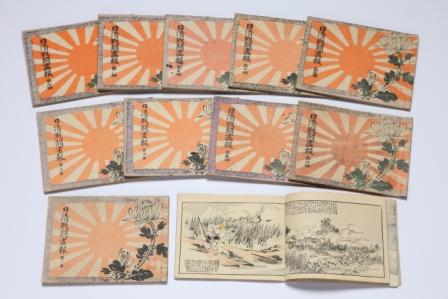
The eleven volumes of 日清戦闘画報 Nisshin Sentō Gahō
(Illustrated Account of the Sino-Japanese War)
The 1894 print Ban-Banzai for the Great Japanese Empire! Illustration of the Assault on Songhwan: A Great Victory for Our Troops by Mizuno Toshikata (1866-1908) depicts Beisen and his sons standing on a hill recording the battle.
In 1897 one of his paintings was among the presents from Japan to Queen Victoria the occasion of her Diamond Jubilee.16
In 1899, he began to suffer from poor eyesight and became totally blind in 1900. During this period he devoted himself to haiku and writing.17 He died of cancer of the stomach on May 19, 1906.
| DEDICATED TO THE MEMORY OF KUBOTA BEISEN A GREAT ARTIST AND A KINDLY MAN, WHOSE HAPPINESS WAS IN HELPING OTHERS AND WHOSE TRIUMPHANT CAREER HAS SHED ENDURING LUSTRE UPON THE ART OF JAPANESE PAINTING - Henry P. Bowie, 1911, On the Laws of Japanese Painting. |
Examples of Work
Pages from the artist's tourbook "米僊漫遊画乗" while in China c. 1890-1900. (Republished in 1947 by Jihee Tanaka Publication.)
Daikoku Shaving the Head of Fukurokuju
福禄寿の剃髪
Museum of Fine Arts, Boston 50.1667
福禄寿の剃髪
Museum of Fine Arts, Boston 50.1667
| 富岳図 Fugaku (Mt. Fuji) Meiji period, hanging scroll, wash drawing 95.8 cm × 178.5 cm Ishikawa Prefectural Museum of Art | 龍虎図 Dragon and Tiger Meiji period, hanging scroll, wash drawing 95 cm × 178.3 cm Ishikawa Prefectural Museum of Art |
地獄太夫之図
Picture of the Courtesan Jigoku Tayū
Picture of the Courtesan Jigoku Tayū
Signatures and Seals
 seal used in ehon illustrations c. 1877 |  | 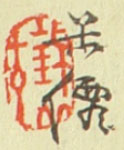 |  Beisen with unread seal |  |  |  |
1 The Sino-JapaneseWar, Nathan Chaikin, self-published, 1983, p.33. [But, I’ve seen no other mention of his father’s name in a half-dozen other sources. Chaikan tells us that Beisen was called Yonekichi as a child, but Merritt (cited below) tells us he was called Beikichi - a matter of translation of the characters 米吉.]
2 The New Far East (with Twelve Illustrations from Special Designs by Kubota Beisen, of Tokio), Arthur Diósy, Cassell and Company, Ltd., 5th Edition, 1904, p. xvi-xvii.
3 Transactions and Proceedings of the Japan Society, London, Transactions and Proceedings, Vol. VI., The Eleventh; Twelfth, and Thirteenth Session, 1901-1904, Kegan Paul, Trench, Trubner and Co., Ltd., London, 1906, p. 164.
4 The Far East: An English Edition of the Kokumin-no-tomo, Vol. 1. No. 1, Kokumin-no-tomo, February 20, 1896, p. 29.
5 Ibid.
6 Op. cit., The New Far East, p. xvii.
7 Op. cit., The Far East, p. 396.
8 Creating a Public: People and Press in Meiji Japan, James. L. Huffman, University of Hawaii Press, 1997, p. 396.
9 Op. cit., The New Far East, p. xvii.
10 Op. cit., The Far East, p. 29.
11 Brooklyn Museum website http://www.brooklynmuseum.org/opencollection/objects/1205/Philadelphia_Bridge
12 On the Laws of Japanese Painting, Henry P. Bowie, Paul Elder and Company Publishers, 1911, p. 4.
13 Ibid. p. 5.
14 Japan at the Dawn of the Modern Age – WoodblockPrints from the Meiji Era, Louise E. Virgin, Donald Keene, et. al.,MFA Publications, 2001, p. 68-69.
15 Op. cit., The New Far East, p. xvii.
16 Ibid.
17 Japan wikipedia http://ja.wikipedia.org/wiki/%E4%B9%85%E4%BF%9D%E7%94%B0%E7%B1%B3%E5%83%8A
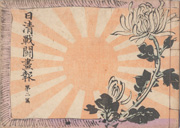
.jpg)
